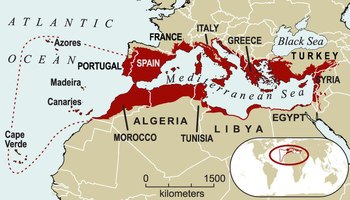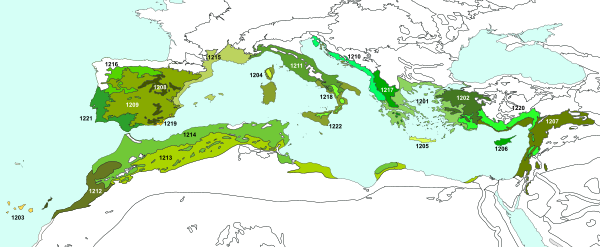Mediterranean Basin
This article needs additional citations for verification. (October 2013) |

In biogeography, the Mediterranean Basin (/ˌmɛdɪtəˈreɪniən/ MED-ih-tə-RAY-nee-ən), also known as the Mediterranean Region or sometimes Mediterranea, is the region of lands around the Mediterranean Sea that have mostly a Mediterranean climate, with mild to cool, rainy winters and warm to hot, dry summers, which supports characteristic Mediterranean forests, woodlands, and scrub vegetation. It was a very important part of Mediterranean civilizations.
Geography
The Mediterranean Basin covers portions of three continents: Europe, Africa, and Asia. It is distinct from the drainage basin, which extends much further south and north due to major rivers ending in the Mediterranean Sea, such as the Nile and Rhône. Conversely, the Mediterranean Basin includes regions not in the drainage basin.[1]
It has a varied and contrasting topography. The Mediterranean Region offers an ever-changing landscape of high mountains, rocky shores, impenetrable scrub, semi-arid steppes, coastal wetlands, sandy beaches and a myriad of islands of various shapes and sizes dotted amidst the clear blue sea. Contrary to the classic sandy beach images portrayed in most tourist brochures, the Mediterranean is surprisingly hilly. Mountains can be seen from almost anywhere.[2]
By definition, the Mediterranean Basin extends from Macaronesia in the west, to the Levant in the east, although some places may or may not be included depending on the view, as is the case with Macaronesia: some definitions only include Madeira and the Canary Islands[3] while others include the whole Macaronesia (with the Azores and Cape Verde).[4]
In Western Asia, it covers the western and southern portions of the peninsula of Anatolia, as far as Iraq,[5] but excluding the temperate-climate mountains of central Turkey. It includes the Mediterranean Levant at the eastern end of the Mediterranean, bounded on the east and south by the Syrian and Negev deserts.
The northern portion of the
Europe lies to the north of the Mediterranean. The European portion of the Mediterranean Basin loosely corresponds to
Geology and paleoclimatology
The Mediterranean Basin was shaped by the ancient collision of the northward-moving African–Arabian continent with the stable Eurasian continent. As Africa–Arabia moved north, it closed the former
About 6 mya during the late Miocene, the Mediterranean was closed at its western end by drifting Africa, which caused the entire sea to evaporate. There followed several (debated) episodes of sea drawdown and re-flooding known as the
The end of the Miocene also marked a change in the Mediterranean Basin's climate. Fossil evidence shows that the Mediterranean Basin had a relatively humid subtropical climate with summer rainfall during the Miocene, which supported
Flora and fauna
The Mediterranean Region was first proposed by German botanist August Grisebach in the late 19th century.
The
- Anagyris
- Andryala
- Aphyllanthes
- Argania
- Argantoniella
- Bellardia
- Biserrula
- Bivonaea
- Bolanthus
- Boleum
- Callicotome
- Ceratocapnos
- Ceratonia
- Chamaerops
- Chronanthus
- Cladanthus
- Coridothymus
- Didesmus
- Dorystoechas
- Drosophyllum
- Euzomodendron
- Fedia
- Guiraoa
- Gyrocarion
- Helicodiceros
- Hermodactylus
- Hutera
- Hymenocarpus
- Ionopsidium
- Lafuentea
- Lagoecia
- Leuzea
- Lycocarpus
- Malope
- Morisia
- Ortegia
- Petromarula
- Phillyrea
- Preslia
- Putoria
- Rothmaleria
- Rosmarinus
- Rupicapnos
- Santolina
- Staehelina
- Soleirolia
- Spartium
- Tetraclinis
- Trachelium
- Tremastelma
- Triplachne
- Vella
The genera
The Mediterranean Basin is the largest of the world's five Mediterranean forests, woodlands, and scrub regions. It is home to a number of plant communities, which vary with rainfall, elevation, latitude, and soil.
- Hebrew.
- macchia in Italian, maquis in French, and "matorral" in Spanish. In some places, shrublands are the mature vegetation type, and in other places the result of the degradation of former forest or woodland by logging or overgrazing, or disturbance by major fires.
- grasses.
- Woodlands are usually dominated by oak and pine, mixed with other sclerophyll and coniferous trees.
- riparianzones along rivers and streams where they receive summer water. Mediterranean forests are generally composed of evergreen trees, predominantly oak and pine. At higher elevations Mediterranean forests transition to mixed broadleaf and tall conifer forests similar to temperate zone forests.
The Mediterranean Basin is home to considerable
Endangered mammals of the Mediterranean Basin include the Mediterranean monk seal, the Barbary macaque, and the Iberian lynx.
Ecoregions
The WWF identifies 22 Mediterranean forests, woodlands, and scrub ecoregions in the Mediterranean Basin, most of which featuring sclerophyll plant species:
- Aegean and Western Turkey sclerophyllous and mixed forests (Greece, Turkey, North Macedonia, Bulgaria)
- Anatolian conifer and deciduous mixed forests (Turkey)
- Canary Islands dry woodlands and forests (Spain)
- Corsican montane broadleaf and mixed forests (France)
- Crete Mediterranean forests (Greece)
- Cyprus Mediterranean forests (Cyprus)
- Eastern Mediterranean conifer–sclerophyllous–broadleaf forests (Lebanon, Iraq, Israel, Jordan, Palestine, Syria, Turkey)
- Iberian conifer forests (Spain)
- Iberian sclerophyllous and semi-deciduous forests (Portugal, Spain)
- Illyrian deciduous forests (Albania, Bosnia and Herzegovina, Croatia, Greece, Italy, Montenegro, Slovenia)
- Italian sclerophyllous and semi-deciduous forests (France, Italy, San Marino)
- ))
- Mediterranean dry woodlands and steppe (Algeria, Egypt, Libya, Morocco, Tunisia)
- Mediterranean woodlands and forests (Algeria, Libya, Morocco, Tunisia)
- Northeastern Spain and Southern France Mediterranean forests (France, Monaco, Spain)
- Northwest Iberian montane forests (Portugal, Spain)
- Pindus Mountains mixed forests (Albania, Greece, North Macedonia)
- South Apennine mixed montane forests (Italy)
- Southeastern Iberian shrubs and woodlands (Spain)
- Southern Anatolian montane conifer and deciduous forests (Lebanon, Israel, Jordan, Syria, Turkey)
- Southwest Iberian Mediterranean sclerophyllous and mixed forests (Portugal, Spain)
- Tyrrhenian–Adriatic sclerophyllous and mixed forests (Croatia, France, Italy, Malta)

History
Neanderthals inhabited western Asia and the non-glaciated portions of Europe starting about 230,000 years ago. Modern humans moved into western Asia from Africa less than 100,000 years ago. Modern humans, known as Cro-Magnons, moved into Europe approximately 50–40,000 years ago.
The most recent glacial period, the Wisconsin glaciation, reached its maximum extent approximately 21,000 years ago, and ended approximately 12,000 years ago. A warm period, known as the Holocene climatic optimum, followed the ice age.
Food crops, including
A strengthening of the summer
Historiography
One of the earliest modern studies of the Mediterranean was
Agriculture
See also
- Ancient Egypt
- Ancient Greece
- Ancient Rome
- Life zones of the Mediterranean region
- Mediterranean wine climate
- MISTRALS
- Ottoman Empire
- Phoenicia
- Zanclean flood
References
- ^ Portugal, Jordan and Iraq
- ISBN 978-92-79-11587-5. Archived(PDF) from the original on September 19, 2017. Retrieved August 6, 2015.
- ISBN 978-2-8317-0912-3. Archivedfrom the original on 26 May 2023. Retrieved 29 November 2020.
- CEPF. Archivedfrom the original on 24 June 2022. Retrieved 29 November 2020.
- ISBN 978-0-19-107874-3.
the Eastern Mediterranean conifer-sclerophyllous-broadleaf forest ecoregion, which extends slightly into Iraq
- from the original on 2024-01-01. Retrieved 2019-04-05.
- .
- (PDF) from the original on 2021-05-07. Retrieved 2021-05-06.
- ISSN 0091-7613.
- from the original on 2012-11-10. Retrieved 2011-12-15 – via sites.google.com.
- ^ Тахтаджян, А. Л. "Флористические деления суши и океана". Древнесредиземноморское подцарство (in Russian). Archived from the original on 2008-06-16. Retrieved 26 January 2019.
- ^ Wacks, David A. (2019). Medieval Iberian Crusade Fiction and the Mediterranean World. University of Toronto Press. p. 4.
Further reading
- Attenborough, David (1987). The First Eden: The Mediterranean world and man. Boston, MA: Little Brown and Company.
- Borutta, Manuel, Mediterraneum, EGO - European History Online, Mainz: Institute of European History, 2021, retrieved: March 8, 2021.
- Dallman, Peter F. (1998). Plant Life in the World's Mediterranean Climates. Berkeley, California: University of California Press.
{{cite book}}:|work=ignored (help) - Suc, J.-P. (1984). "Origin and evolution of the Mediterranean vegetation and climate in Europe". Nature. 307 (5950): 429–432. S2CID 4318726.
- Wagner, Horst-Günter (2011). Mittelmeerraum, Geography, History, Economy. Darmstadt: Wissenschaftliche Buchgesellschaft. ISBN 978-3-534-23179-9.
